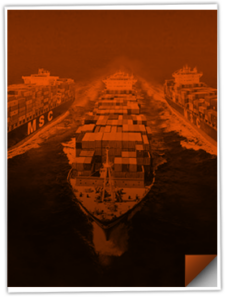Featured Headlines:
Panama Canal: Running a Little Bit Hot Tonight
All in the (Electric) Family: JFK’s Terminal 6 Sparks Change
Who’s Picking Up the Tab? Qualified Parties for International Mail Duties
CBP Slaps an ACE Bandage on Automated Rejections
Certified Fresh: USDA Tightens Rules for Organic Imports
FAA Turns Up the Heat on Hazardous Shipments
Hull Yeah: Efficiency Takes the Wheel in Shipping's Green Race
Cargo Crossroads: LTL Limping, Rails Racing, and Regulators Retooling
X’s, O’s, and Ocean Flows
- Madrid matchpoint: U.S. and China negotiators edge closer on TikTok, playing a high-stakes game of tic-tac-toe. Neither side wants to leave the center square open, while shippers just want someone—anyone—to win already so trade can keep moving.
- Rates go for the triple: China–US West Coast spot rates jumped 7% last week to $2,309/FEU, up a whopping 34% since late August. East Coast lanes climbed 4% to $3,368/FEU, boosted by GRIs, blank sailings, and Golden Week. For carriers, that’s two in a row—and they’re eyeing the diagonal.
- Tariffs keep the board messy: The 30% China tariff extension through November slows the slide in demand, but doesn’t line up a full row of buyers. National Retail Federation (NRF) projects second-half imports down 10% year-over-year (YoY): October off 13%, November/December down 20%. Retailers are cautious—nobody wants to be the one forced into the losing square.
- Frontloading déjà vu: September imports came in 16% above forecast thanks to tariff timing. But the term “frontloading” has been tossed around so often—during the ILA strike scare, the Trump tariff tour, the election tremors, Chinese New Year rush—that it’s losing all meaning. Sounds more like a grizzly at a buffet than a logistics strategy. Still, our replacement terms, “strategic inventory planning,” “accelerated shipping,” “pre-emptive buying”, all get blocked. Guess “frontloading” takes the center square again.
- Carriers shuffle the pieces: Ocean Network Express (ONE) is moving 10 Chinese-built vessels in U.S. service and splitting its Premier Alliance into two new loops: Asia–Med and Middle East–US. Why? To avoid potential U.S. surcharges on China-linked cargo starting October 14—unless the trade talks end in a tic-tac-toe tie; the cat wins, shippers lose, and the game just resets.
- Shapiro knows its way around the tic-tac-toe board. Contact our freight experts today to learn how to master the X’s, O’s, and Ocean Flows in your supply chain!
Panama Canal: Running a Little Bit Hot Tonight
- We, the editorial staff at Shapiro, must thank Eddie Van Halen for literally ghost-writing this article. RIP, Eddie!
- Jump back, what’s that sound? It’s the Panama Canal Authority (ACP) cranking the amp to $8 billion on a ten-year setlist—water projects, a cross-country road, a shiny LPG pipeline, and dual container/Ro-Ro stages. Call it the world tour for global trade’s MVP.
- Rio Indio Dam is their power ballad: $1.6B (plus $400M to relocate 2,500 residents) to keep both Panama’s people and the famous Canal hydrated. A recent prolonged drought cut daily ship slots from 36 to 24—talk about losing her in the turn.
- This will be hot shoes (and wet locks) burnin’ down the avenue, gang!
- On the energy track, a 76 km “propane express lane” will let up to 2.5M barrels a day fly between oceans without hitting the locks. Pistons popping, no stopping now—LPG’s got the feel for the wheel.
- The encore? Corozal container port, with a study due Q1 2026 and construction revving up in 2028. Linked by road and rail, it aims to be the Canal’s primary logistics hub—a shiny machine, moving parts clean.
- ACP swears it’s all “gonna” be transparent, with international tenders and open mic nights for who gets to play lead guitar (aka build the thing).
- Panama! Panamaha! Panama Canal, oh-oh-oh-oh!!
All in the (Electric) Family: JFK’s Terminal 6 Sparks Change
- Forget Archie Bunker yelling about “stifling,” or Doug Heffernan struggling to park his delivery truck in Queens—JFK’s new Terminal 6 is stifling diesel fumes once and for all.
- The Port Authority and its pals at JFK Millennium Partners (JMP) have brought in Fortbrand Services to babysit the nation’s first all-electric, pooled ground support fleet. No more airlines hoarding their own noisy, smoke-belching gear like Archie guarding the good chair in the living room.
- Instead, T6 will roll out shared electric tractors, loaders, and assorted gizmos at all 10 gates—basically the Queens version of “sharing a driveway without throwing punches.”
- Each vehicle will be tracked in real time for battery, GPS, driver access, and upkeep. It’s like Carrie checking Doug’s cholesterol, but with lithium-ion.
- By going electric, the terminal will slash 2,500 metric tons of CO₂ every year—the same as driving a gas guzzler six million miles… or the King of Queens making a sandwich run to Arthur’s basement fridge every day for eternity.
- And the eco-stuff doesn’t stop there: over 4,000 solar panels, stormwater reuse, high-efficiency building systems, and a whopping 90% construction waste diversion are already built in. Edith would call it “sustainable,” Archie would call it “commie nonsense,” and Carrie would just say “finally.”
- All of this plugs into the Port Authority’s 2022 zero-emission rule, which requires every piece of airside ground equipment to go electric by 2030. More than 1,500 e-GSE units are already zipping around JFK, LaGuardia, and Newark.
- With JFK’s $19 billion glow-up—Terminals 1, 4, 5, 6, and 8 all in play—the airport’s facelift is bigger than anything even Queens Boulevard has seen. In short: the future is bright, quiet, and powered by batteries instead of Bunkers (or bunker fuel).
Who’s Picking Up the Tab? Qualified Parties for International Mail Duties
- The glory days of de minimis duty-free treatment officially ended on August 29, 2025. Now, even the smallest international mail shipments carry a duty bill, thanks to Executive Order 14324.
- The first stop for that bill is the international mail carrier—but US Customs and Border Protection (CBP) is allowing certain qualified third parties to step in and pay on their behalf.
- To keep things orderly, CBP is publishing and updating a list of approved parties through CSMS # 65934463 and on CBP.gov. If a name isn’t on that list, it isn’t qualified.
- So, what makes someone “qualified”? At a minimum: a basic importation and entry bond, the ability to remit duties in full, and a worksheet packed with the right data elements.
- Once CBP processes a Form 5106 and confirms the bond is on file, the party is officially cleared to pick up the tab on international mail shipments.
CBP Slaps an ACE Bandage on Automated Rejections
- Starting September 27, 2025, CBP will flip the switch on a new Automated Commercial Environment (ACE) enhancement that automatically rejects manifest filings if cargo information is incomplete or vague.
- The target? Filings missing clear cargo descriptions, full consignee details, or accurate shipper information—all essentials for compliance.
- To reinforce this, CBP is also deploying new disposition codes that will signal when a hold is placed or lifted due to insufficient data.
- The move underscores CBP’s expectation that filers provide shipment details that meet the standards in 19 CFR § 4.7a (Vessel), 122.48a (Air), 123.91 (Rail), 123.92 (Truck), and 128.21 (Express Consignments).
- Required information includes:
- Cargo Description: Clear, specific, and accurate enough for CBP to identify the commodity.
- Consignee Information: The name and address of the party set to receive delivery.
- Shipper Information: The full name and address of the foreign party initiating the shipment.
- For more details, including the full set of new disposition codes, see the Trade User Information Notice.
- Don’t get caught with a rejected manifest. Shapiro can help review your processes, tighten cargo descriptions, and keep your filings ACE-compliant from the start. Contact us at [email protected] today!
Certified Fresh: USDA Tightens Rules for Organic Imports
- Beginning October 1, 2025, the US Department of Agriculture (USDA) will no longer allow organic shipments without a National Organic Program Import Certificate (NOPIC) to simply be relabeled as conventional.
- Before this change, importers had the option to downgrade products—bringing them in as non-organic instead of organic—but that door is closing.
- Going forward, any shipment missing an NOPIC at arrival will face far stricter consequences: re-export, destruction, or donation (with restrictions).
- The policy underscores USDA’s push for tighter control over organic labeling integrity at the border.
- For additional details, see the official USDA Organic Regulations webpage.
- Don’t let your organics go to waste! Shapiro’s compliance experts can help you secure the right documentation and keep your shipments certified fresh.
FAA Turns Up the Heat on Hazardous Shipments
- The Federal Aviation Administration (FAA) has turned its spotlight on lithium-ion battery shippers, after three separate incidents involving undeclared or improperly packaged cargo sparked fires and safety alarms on FedEx and UPS aircraft.
- Mobile Sentrix, a Virginia-based supplier of mobile phone parts, was hit with a $170,000 fine for multiple violations, including four undeclared battery shipments to FedEx last year. In one case, a fire broke out and three batteries fused together mid-shipment.
- On the West Coast, Mokwheel Bikes of Ontario, California, faces a $74,250 penalty after trying to ship undeclared batteries via UPS to Shenzhen, China in late 2023.
- Not only were the batteries mislabeled, but the company also failed to train employees on hazmat handling or provide emergency response information. UPS caught the shipment in Anchorage before it left U.S. soil.
- Meanwhile, LG Energy Solution of Seoul, South Korea, was fined $60,000 when a package of five lithium-ion batteries bound for Los Angeles ignited inside FedEx’s Irvine facility.
- Lithium-ion batteries are classified as Class 9 dangerous goods under the U.S. Department of Transportation (DOT), International Air Transport Association (IATA), and carrier-specific rules, requiring strict packaging and labeling.
- Airlines have long warned that sloppy compliance is a recipe for disaster as the use of lithium batteries soars worldwide.
Hull Yeah: Efficiency Takes the Wheel in Shipping's Green Race
- Fuel efficiency has always mattered in shipping, but with cheap heavy fuel oil dominating historically, true large-scale optimization often needs regulatory muscle.
- That push is coming: the EU already regulates shipping emissions, and the International Maritime Organization (IMO) could adopt the first-ever global, enforceable decarbonization treaty at its October meeting.
- Efficiency measures range from the flashy (rigid wingsails, rotor sails, and air-lubricated hulls) to the simple (hull cleaning, bulbous bows, and route optimizations). Many are cheaper and available now, bridging the gap while greener fuels develop.
- Europe is leading the charge: France’s Canopée has already run at 14 knots on wind alone, thanks to rigid OceanWings sails. Norway’s ECOsubsea uses underwater robots to clean hulls without polluting, typically saving ships more than 5% in fuel costs—often recouped in a month.
- Navigation tech is another game-changer: France’s D-ICE and Finland’s NAPA offer advanced software that slashes emissions 15–20% (and up to 40% with wind assistance).
- Still, experts stress the economics: efficiency upgrades often face “split incentives” between shipowners, operators, and cargo owners. Without strong regulations, progress stalls… or, as ZESTAs’ Madadh MacLaine bluntly put it: “Nobody’s doing this because they’re nice. It’s all about the money.”
- The IMO’s October vote on a net-zero framework could reshape incentives: stricter yearly efficiency standards plus tiered fines would make wasted fuel a costlier habit.
Cargo Crossroads: LTL Limping, Rails Racing, and Regulators Retooling
- LTL: Waiting for the Turn
- August brought little joy to the nation’s less-than-truckload (LTL) carriers. Old Dominion, XPO, and Saia all posted shipment declines—down 8.2%, 3.4%, and 2.2%, respectively—even as U.S. manufacturing showed modest growth.
- The four-year freight slump refuses to budge, though analysts spy a glimmer of hope in 2026. Armada Corporate Intelligence argues that inventory-to-sales ratios look worse on paper than in reality—only about 7% of the market is genuinely overstocked.
- If consumer spending holds steady, restocking shelves could finally put trucking back in gear by early 2026.
- Rail: Redrawing the Map
- While trucking idles in the slow lane, railroads are busy rerouting the future.
Canadian National and CSX have teamed up on a new international intermodal service connecting Canada’s West Coast to Nashville—a bypass that gives shippers an alternative to Savannah. - CSX is also nearing the reopening of two long-stalled arteries: Baltimore’s historic Howard Street Tunnel and the Blue Ridge Subdivision linking North Carolina and Tennessee. The tunnel upgrade will eventually allow double-stacks, strengthening CSX’s hand against Norfolk Southern—though full capacity won’t be reached until spring. Uh huh… come on, hon… we’ve talked about double stacking in Bal’more since John Waters began filming!
- Meanwhile, Union Pacific and Norfolk Southern are joining forces in October to launch a domestic intermodal service linking Louisville with West, Gulf, and Pacific Northwest ports via Kansas City’s newly expanded terminal.
- While trucking idles in the slow lane, railroads are busy rerouting the future.
- Regulators: All Eyes on Safety
- On the regulatory front, the Federal Motor Carrier Safety Administration is gearing up for its most ambitious crash study in decades.
- Starting in 2026, the agency will analyze 2,000 fatal heavy-truck crashes across 30 states, with a spotlight on Class 7 and 8 vehicles.
- The Crash Causal Factors Program aims to untangle the root causes of deadly accidents and shape policies to make America’s highways less perilous.



